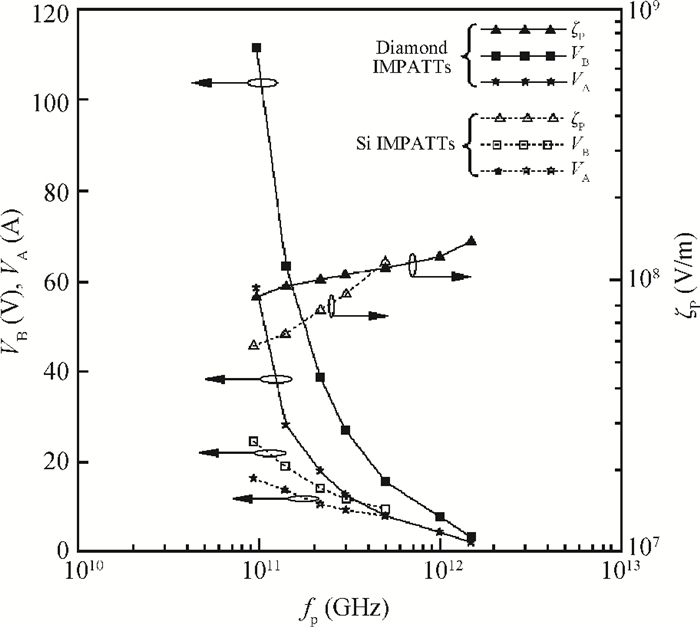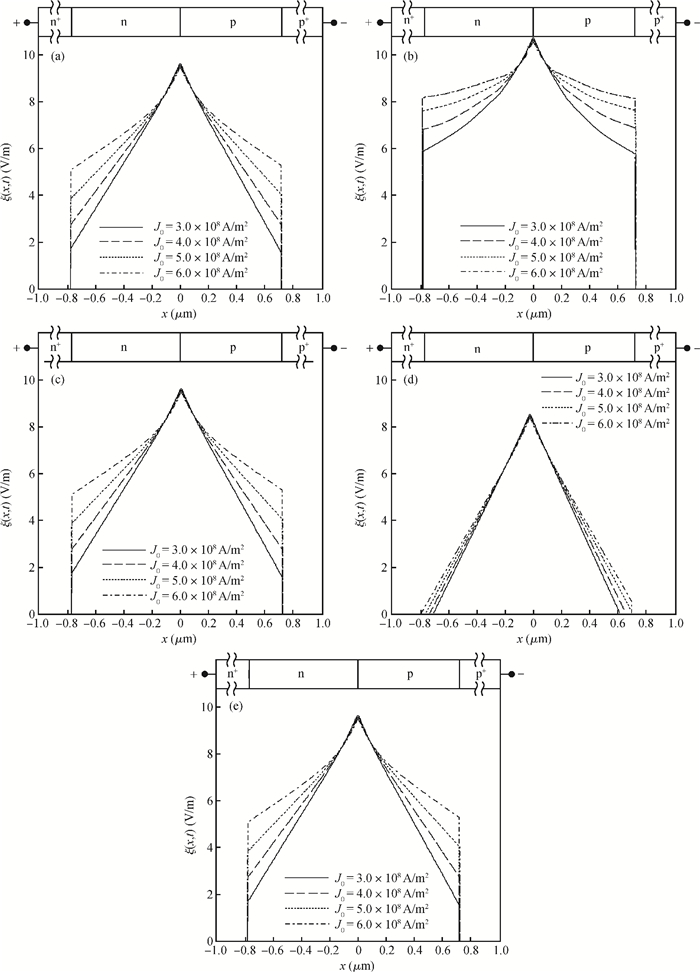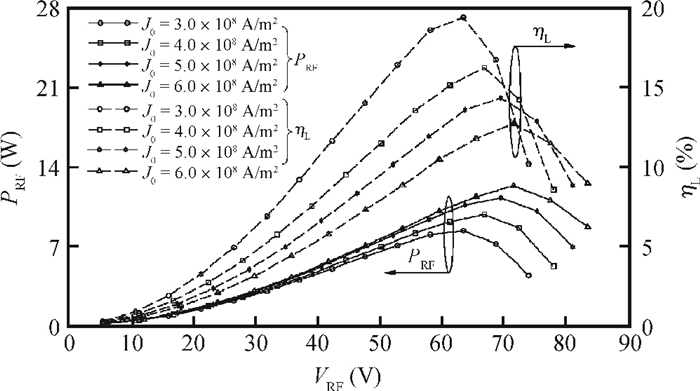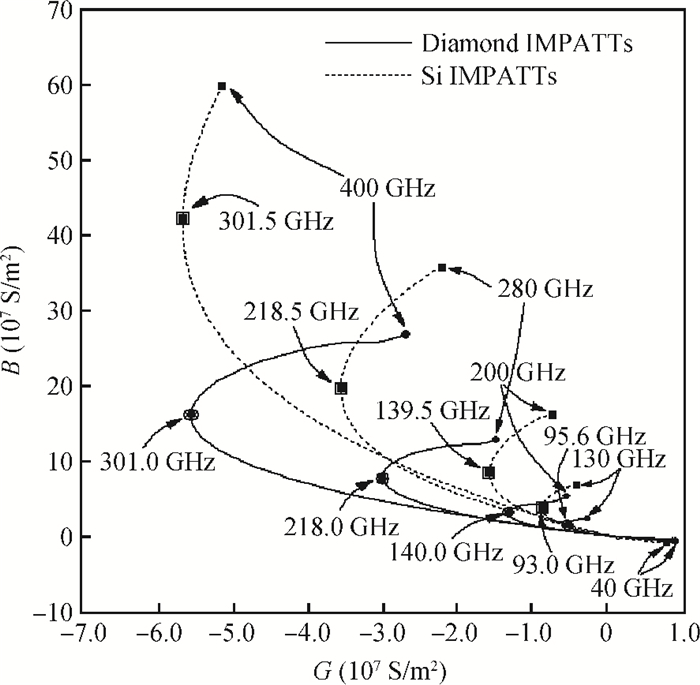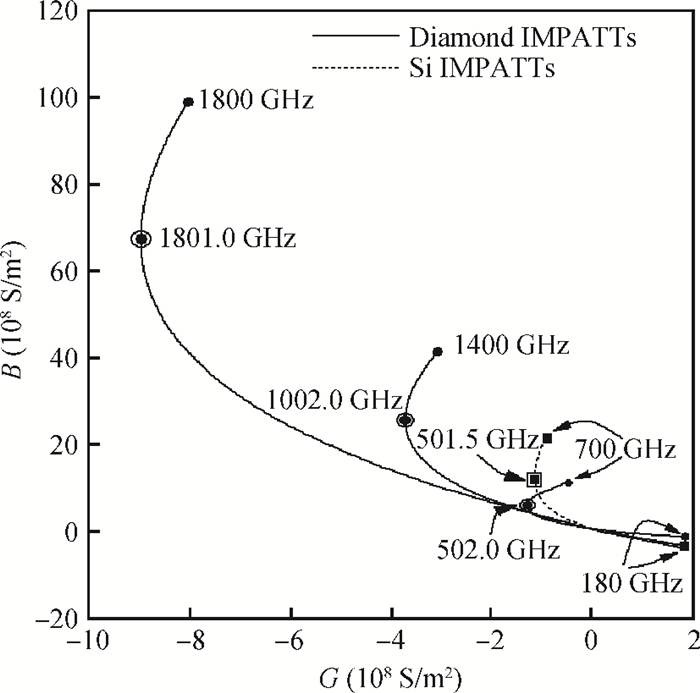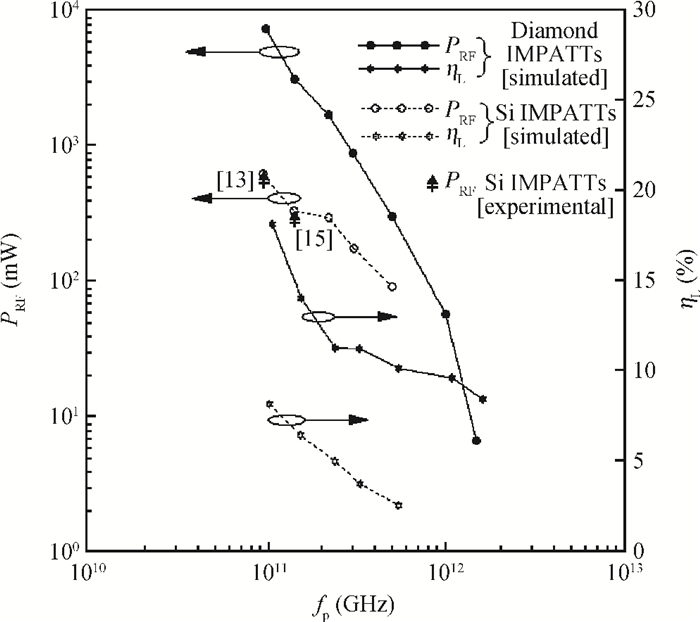| Citation: |
Aritra Acharyya, Suranjana Banerjee, J. P. Banerjee. Potentiality of semiconducting diamond as the base material of millimeter-wave and terahertz IMPATT devices[J]. Journal of Semiconductors, 2014, 35(3): 034005. doi: 10.1088/1674-4926/35/3/034005
****
A Acharyya, S Banerjee, J. P. Banerjee. Potentiality of semiconducting diamond as the base material of millimeter-wave and terahertz IMPATT devices[J]. J. Semicond., 2014, 35(3): 034005. doi: 10.1088/1674-4926/35/3/034005.
|
Potentiality of semiconducting diamond as the base material of millimeter-wave and terahertz IMPATT devices
DOI: 10.1088/1674-4926/35/3/034005
More Information
-
Abstract
An attempt is made in this paper to explore the potentiality of semiconducting type-Ⅱb diamond as the base material of double-drift region (DDR) impact avalanche transit time (IMPATT) devices operating at both millimetre-wave (mm-wave) and terahertz (THz) frequencies. A rigorous large-signal (L-S) simulation based on the non-sinusoidal voltage excitation (NSVE) model developed earlier by the authors is used in this study. At first, a simulation study based on avalanche response time reveals that the upper cut-off frequency for DDR diamond IMPATTs is 1.5 THz, while the same for conventional DDR Si IMPATTs is much smaller, i.e. 0.5 THz. The L-S simulation results show that the DDR diamond IMPATT device delivers a peak RF power of 7.79 W with an 18.17% conversion efficiency at 94 GHz; while at 1.5 THz, the peak power output and conversion efficiency decrease to 6.19 mW and 8.17% respectively, taking 50% voltage modulation. A comparative study of DDR IMPATTs based on diamond and Si shows that the former excels over the later as regards high frequency and high power performance at both mm-wave and THz frequency bands. The effect of band to band tunneling on the L-S properties of DDR diamond and Si IMPATTs has also been studied at different mm-wave and THz frequencies.-
Keywords:
- diamond IMPATTs,
- DDR,
- large-signal simulation,
- millimeter-wave,
- terahertz
-
References
[1] Chan W L, Deibel J, Mittleman D M. Imaging with terahertz radiation. Rep Prog Phys, 2007, 70:1325 doi: 10.1088/0034-4885/70/8/R02[2] Grischkowsky D, Keiding S, Exter M, et al. Far-infrared time-domain spectroscopy with terahertz beams of dielectrics and semiconductors. J Opt Soc Am B, 1990, 7:2006 doi: 10.1364/JOSAB.7.002006[3] Debus C, Bolivar P H. Frequency selective surfaces for high sensitivity terahertz sensing. Appl Phys Lett, 2007, 91:184102 doi: 10.1063/1.2805016[4] Yasui T, Yasuda T, Sawanaka K, et al. Terahertz parameter for noncontact monitoring of thickness and drying progress in paint film. Appl Opt, 2005, 44:6849 doi: 10.1364/AO.44.006849[5] Stoik C D, Bohn M J, Blackshire J L. Nondestructive evaluation of aircraft composites using transmissive terahertz time domain spectroscopy. Opt Express, 2008, 16:17039 doi: 10.1364/OE.16.017039[6] Jördens C, Koch M. Detection of foreign bodies in chocolate with pulsed terahertz spectroscopy. Opt Eng, 2008, 47:037003 doi: 10.1117/1.2896597[7] Fitzgerald A J, Cole B E, Taday P F. Nondestructive analysis of tablet coating thicknesses using terahertz pulsed imaging. J Pharm Sci, 2005, 94:177 doi: 10.1002/jps.20225[8] Siegel P H. Terahertz technology in biology and medicine. IEEE Trans Microw Theory Tech, 2004, 52:2438 doi: 10.1109/TMTT.2004.835916[9] Siegel P H. THz Instruments for space. IEEE Trans Antenn Propag, 2007, 55:2957 doi: 10.1109/TAP.2007.908557[10] Lynch S A, Paul D J, Townsend P, et al. Silicon quantum cascade lasers for THz sources. Proc 18th Annual Meeting of the IEEE on Lasers and Electro-Optics Society, Leos, 2005:728 http://ieeexplore.ieee.org/document/1548213/[11] Seo M, Urteaga M, Hacker J, et al. InP HBT IC technology for terahertz frequencies:fundamental oscillators up to 0.57 THz. IEEE J Solid-State Circuits, 2011, 46:2203 doi: 10.1109/JSSC.2011.2163213[12] Midford T A, Bernick R L. Millimeter wave CW IMPATT diodes and oscillators. IEEE Trans Microw Theory Tech, 1979, 27:483 doi: 10.1109/TMTT.1979.1129653[13] Luy J F, Casel A, Behr W, et al. A 90-GHz double-drift IMPATT diode made with Si MBE. IEEE Trans Electron Devices, 1987, 34:1084 doi: 10.1109/T-ED.1987.23049[14] Dalle C, Rolland P, Lieti G. Flat doping profile double-drift silicon IMPATT for reliable CW high power high-efficiency generation in the 94-GHz window. IEEE Trans Electron Devices, 1990, 37:227 doi: 10.1109/16.43820[15] Wollitzer M, Buchler J, Schafflr F, et al. D-band Si-IMPATT diodes with 300 mW CW output power at 140 GHz. Electron Lett, 1996, 32:122 doi: 10.1049/el:19960088[16] Eisele H, Hadded G I. GaAs TUNNETT diodes on diamond heat sinks for 100 GHz and above. IEEE Trans Microw Theory Tech, 1995, 43:210 doi: 10.1109/22.362989[17] Eisele H, Chen C C, Munns G O, et al. The potential of InP IMPATT diodes as high-power millimeter-wave sources:first experimental results. IEEE MTT-S International Microwave Symposium Digest, 1996, 2:529 http://ieeexplore.ieee.org/document/510989/[18] Yuan A, James J, Cooper A, et al. Experimental demonstration of a silicon carbide IMPATT oscillator. IEEE Electron Device Lett, 2001, 22:266 doi: 10.1109/55.924837[19] Vassilevski K V, Zorenko A V, Zekentes K, et al. 4H-SiC IMPATT diode fabrication and testing. Technical Digest of International Conference on SiC and Related Materials, Tsukuba, Japan, 2001:713 https://www.scientific.net/MSF.389-393.1353[20] Panda A K, Pavlidis D, Alekseev E. DC and high-frequency characteristics of GaN-based IMPATTs. IEEE Trans Electron Devices, 2001, 48:820 doi: 10.1109/16.915735[21] Acharyya A, Banerjee J P. Potentiality of IMPATT devices as terahertz source:an Avalanche response time based approach to determine the upper cut-off frequency limits. IETE Journal of Research, 2013, 59:118 doi: 10.4103/0377-2063.113029[22] Acharyya A, Banerjee J P. Prospects of IMPATT devices based on wide bandgap semiconductors as potential terahertz sources. Applied Nanoscience, 2012:DOI 10.1007/s13204-012-0172-y doi: 10.1007/s13204-012-0172-y[23] Trew R J, Yan J B, Mock P M. The potentiality of diamond and SiC electronic devices for microwave and millimeter-wave power applications. Proc IEEE, 1991, 79:598 doi: 10.1109/5.90128[24] Osman M A, Andrews G, Kreskovsky J P, et al. Numerical simulation studies of semiconducting diamond electronic devices. Final Report on Contract DNA001-87-C-0250, Defense Nuclear Agency, 1989[25] Acharyya A, Datta K, Ghosh R, et al. Diamond based DDR IMPATTs:prospects and potentiality as millimeter-wave source at 94 GHz atmospheric window. Radioengineering, 2013, 22:624 https://dspace.vutbr.cz/xmlui/handle/11012/36894?show=full[26] Mock P. M, Trew R J. RF performance characteristics of double-drift MM-wave diamond IMPATT diodes. Proc IEEE/Cornell Conf. Advanced Concepts in High-Speed Semiconductor Devices and Circuits, 1989:383[27] Miswa T. Negative resistance in p-n junctions under avalanche breakdown conditions. IEEE Trans Electron Devices, 1966, 33:137[28] Gilden M, Hines M E. Electronic tuning effects in the read microwave Avalanche diode. IEEE Trans Electron Devices, 1966, 13(1):169 http://ieeexplore.ieee.org/document/1474242/[29] Gummel H K, Scharfetter D L. Avalanche region of IMPATT diodes. Bell Sys Tech J, 1966, 45:1797 doi: 10.1002/bltj.1966.45.issue-10[30] Evans W J, Haddad G I. A Large-signal analysis of IMPATT diodes. IEEE Trans Electron Devices, 1968, 15(10):708 doi: 10.1109/T-ED.1968.16503[31] Scharfetter D L, Gummel H K. Large-signal analysis of a silicon read diode oscillator. IEEE Trans Electron Devices, 1969, 6(1):64 http://ieeexplore.ieee.org/document/1475609/[32] Gupta M S, Lomax R J. A Current-excited large-signal analysis of IMPATT devices and its circuit implementations. IEEE Trans Electron Devices, 1973, 20:395 doi: 10.1109/T-ED.1973.17661[33] Acharyya A, Banerjee S, Banerjee J P. A proposed simulation technique to study the series resistance and related millimeter-wave properties of Ka-band Si IMPATTs from the electric field snap-shots. International Journal of Microwave and Wireless Technologies, 2013, 5:91 doi: 10.1017/S1759078712000839[34] Acharyya A, Chakraborty J, Das K, et al. Large-signal characterization of DDR silicon IMPATTs operating up to 0.5 THz. International Journal of Microwave and Wireless Technologies, 2013, 5:567 doi: 10.1017/S1759078713000597[35] Acharyya A, Chakraborty J, Das K, et al. Large-signal characterization of DDR silicon IMPATTs operating in millimeter-wave and terahertz regime. Journal of Semiconductors, 2013, 34:104003 doi: 10.1088/1674-4926/34/10/104003[36] Acharyya A, Banerjee S, Banerjee J P. Influence of skin effect on the series resistance of millimeter-wave IMPATT devices. Journal of Computational Electronics, 2013, 12:511 doi: 10.1007/s10825-013-0470-y[37] Acharyya A, Mukherjee M, Banerjee J P. Effects of tunnelling current on mm-wave IMPATT devices. International Journal of Electronics, 2013, in press doi: 10.1080/00207217.2014.982211?needAccess=true&journalCode=tetn20[38] Acharyya A, Mukherjee M, Banerjee J P. Influence of tunnel current on DC and dynamic properties of silicon based terahertz IMPATT source. Terahertz Science and Technology, 2011, 4:26 http://www.tstnetwork.org/March2011/tst-v4n1-26Influence.pdf[39] Konorova E A, Kuznetsov Y A, Sergienko V F, et al. Impact ionization in semiconductor structures made of ion-implanted diamond. Sov Phys Semicond, 1983, 17:146[40] Grant W N. Electron and hole ionization rates in epitaxial silicon. Solid State Electron, 1973, 16:1189 doi: 10.1016/0038-1101(73)90147-0[41] Ferry D K. High-field transport in wide-bandgap semiconductors. Phys Rev B, 1975, 12:2361[42] Canali C, Gatti E, Kozlov S F, et al. Electrical properties and performances of neutral diamond nuclear radiation detectors. Nucl Instrum Methods, 1979, 160:73 doi: 10.1016/0029-554X(79)90167-8[43] Canali C, Ottaviani G, Quaranta A A. Drift velocity of electrons and holes and associated anisotropic effects in silicon. J Phys Chem Solids, 1971, 32:1707 doi: 10.1016/S0022-3697(71)80137-3[44] http://www.ioffe.ru/SVA/NSM/Semicond, accessed, April 2013[45] Sze S M, Ryder R M. Microwave Avalanche diodes. Proc IEEE, Special Issue on Microwave Semiconductor Devices, 1971, 59:1140 http://ieeexplore.ieee.org/abstract/document/1450290/[46] Sridharan M, Roy S K. Computer studies on the widening of the avalanche zone and decrease on efficiency in silicon X-band symmetrical DDR. Electron Lett, 1978, 14:635 doi: 10.1049/el:19780427 -
Proportional views





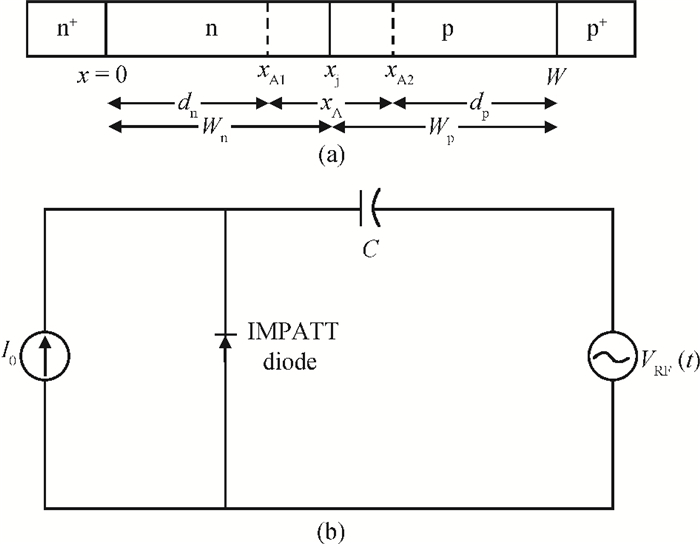
 DownLoad:
DownLoad:
